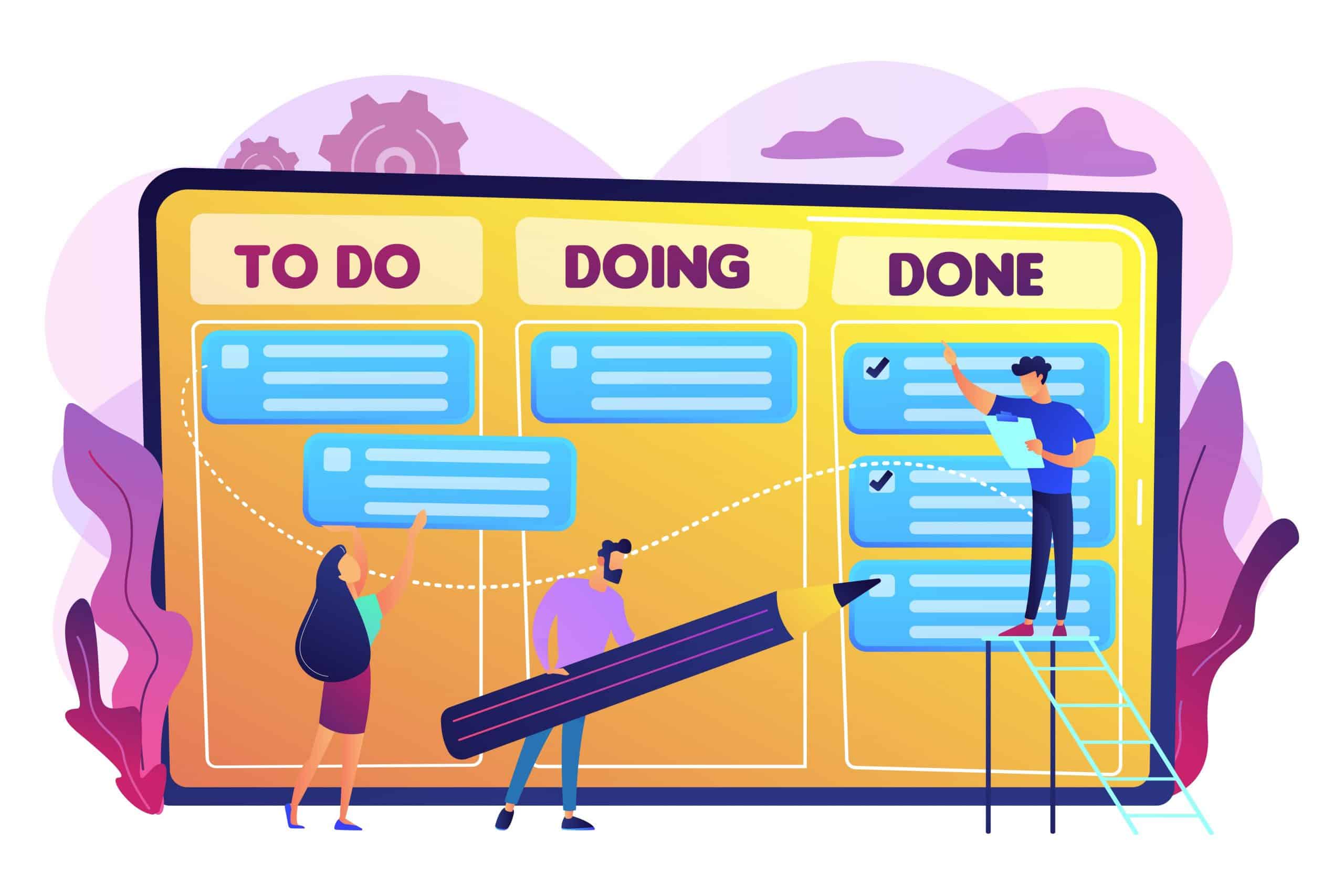The cornerstone of achievement often lies in the successful delivery of projects, many successful organizations say.These successful project delivery involves the use of effective project management methods. Among these methodologies is Kanban management, a method with which you’re likely familiar.
In this blog, we are going to walk you through the inside mechanics of Kanban view, how it works, the key elements, the core principles, and more. So, join us and make your project management easier than ever!
What is Kanban?

Literally, Kanban is a Japanese manufacturing system wherein the supply of components is controlled by instruction cards sent along the production line.
In Japanese, “kanban” directly translates to “signboard.” In Kanban teams, each work item is depicted as an individual card on the board. The primary aim of visualizing work as cards on the Kanban board is to enable team members to track progress through its workflow with visual clarity.
But as we come to project Kanban, it is the visual representation of work items on a kanban board, allowing the team to see the status of works at any time.
Key Elements of Kanban
1. Kanban Board

A Kanban board is an agile project management tool developed to aid in visualizing tasks, limit work-in-progress, and optimizing efficiency. Think of it as a virtual representation of your project’s journey, segmented into distinct stages. These stages are typically depicted as columns, each representing a different phase of the project lifecycle like “To Do,” “In Progress,” “Pause,” and “Done.”
2. Kanban Cards

Each task or work item is represented by a card that moves across the Kanban board as it progresses through various stages of completion. Kanban cards contain essential details regarding project & task name, task description, estimated duration, priority levels, and deadlines. By providing a snapshot of each task’s details, Kanban cards facilitate efficient communication and collaboration among team members, ensuring everyone stays aligned and informed throughout the project lifecycle.
3. WIP Limits
WIP limits restrict the number of tasks allowed in each stage of the Kanban board, preventing team members from overloading themselves with too many responsibilities. By imposing these restrictions, Kanban promotes a focus on completing tasks one at a time, thereby enhancing productivity, reducing lead times, and minimizing the risk of resource exhaustion or burnout.
4 Key Principles of Kanban: Building Blocks of Success
As the journey through Kanban project management continues, it’s crucial to understand the foundational principles that underpin this methodology. These principles serve as guiding lights, illuminating the path towards efficient workflow management, continuous improvement, and organizational agility. Let’s explore the core principles and its significance within the context of Kanban boards and methodology.
1. Start with What You Do Now
Kanban encourages teams to begin their improvement efforts by acknowledging and embracing their current state. This principle emphasizes the importance of understanding existing workflows, processes, and systems before attempting to implement change. This principle translates into leveraging Kanban boards to visualize current workflows accurately.
By mapping out existing processes on the board, teams can identify inefficiencies, bottlenecks, and areas of waste. This serves as the foundation for implementing incremental changes that drive continuous improvement and enhance overall productivity.
2. Agree to Pursue Incremental, Evolutionary Change
Kanban advocates for a gradual, evolutionary approach to change rather than large-scale, disruptive transformations. This principle emphasizes the importance of making small, incremental adjustments over time, based on empirical data and feedback. Within Kanban methodology, this principle manifests through the iterative refinement of workflows and processes depicted on Kanban boards.
Teams continuously track performance metrics and customer feedback, identifying opportunities for improvement and implementing small, targeted changes to enhance efficiency and quality.
3. Respect the Current Process, Roles, Responsibilities, and Titles
Kanban recognizes the value of existing processes, roles, responsibilities, and titles within an organization. This principle emphasizes the importance of respecting the knowledge, expertise, and contributions of team members.
In Kanban boards, this principle entails aligning the board’s structure and workflow stages with existing organizational processes and roles. Additionally, this principle encourages inclusivity and diversity of perspectives, recognizing that leadership can emerge at all levels of the organization.
4. Encourage the Act of Leadership at All Levels in Your Organization
Kanban values collaboration but also empowers individuals to take ownership of and resolve issues. With compelling justification and supporting data, anyone should feel empowered to take action. Within Kanban project management, this principle manifests through empowering team members to take ownership of their tasks, collaborate effectively, and contribute to continuous improvement initiatives.
By encouraging the act of leadership at all levels, organizations enhance their teams and drive meaningful change and innovation.
Putting Kanban into Action: A Step-by-Step Guide
As already discussed, in the project management methodologies, Kanban stands out as a powerful tool for enhancing efficiency and productivity. If you’re looking to optimize your team’s workflow and boost productivity, implementing Kanban could be the solution you’ve been seeking.Here’s a step-by-step guide to implement kanban in action:
Define Your Workflow
Before Kanban implementation, it’s crucial to define your workflow. Identify the key stages your tasks typically go through from conception to completion. Whether you’re managing software development, marketing campaigns, or any other project, understanding your workflow is the first step towards effective Kanban management.
Create a Kanban Board
With your workflow clearly defined, the next step is to create a Kanban board. This board serves as a visual representation of your workflow, allowing you to track the progress of tasks in real-time. You can opt for a physical board using a whiteboard and sticky notes or choose from a plethora of digital Kanban tools available online. Popular digital Kanban tools include Desklog, Trello, and Jira, each offering unique features to suit your needs.
Write Down Your Tasks
Create backlogs for your projects, make use of 1 3 5 rule and prioritize your projects and add them to cards on your Kanban board. Each card represents a specific task, with relevant details such as task description, priority level, and assigned team member. By visualizing your tasks on the Kanban board, you gain clarity on what needs to be done and can easily track progress at a glance.
Set WIP Limits
One of the key principles of Kanban is limiting work in progress (WIP) to maintain flow and prevent bottlenecks. Determine a comfortable number of tasks for each stage of your workflow and set WIP limits accordingly. By restricting the number of tasks in progress at any given time, you ensure that team members focus on completing tasks rather than starting new ones prematurely.
Hold Regular Meetings
To ensure the effectiveness of your Kanban system, it’s essential to hold regular meetings to review progress, identify bottlenecks, and adapt as needed. These meetings, often referred to as Kanban stand-ups or check-ins, provide an opportunity for team members to collaborate, share updates, and address any issues hindering progress. By fostering open communication and collaboration, you empower your team to overcome obstacles and achieve their goals.
Pros and Cons of Kanban
Pros of Kanban  |
Cons of Kanban  |
|---|---|
| Kanban provides a visual representation of tasks and their progress, enhancing transparency and clarity. | Kanban is less prescriptive compared to other methodologies, which may lead to confusions in some cases. |
| Laying out your project tasks on a kanban board makes it clear what the team needs to do to progress on the project. | Without explicit priority settings, Kanban may not emphasize the importance of tasks, potentially leading to confusion. |
| By limiting work in progress (WIP) and focusing on completing tasks, Kanban promotes a steady and efficient flow of work. | Without proper maintenance, your kanban board might become too complex and prove counterproductive for your team’s efficiency. |
| Kanban encourages continuous improvement through regular reflection and adaptation, fostering a culture of learning and innovation. | Successful implementation of Kanban requires discipline and commitment from all team members to adhere to the principles and practices consistently. |
| Kanban promotes collaboration and communication among team members, facilitating better coordination and problem-solving. | While effective for many workflows, Kanban may not be the best choice for highly complex projects with extensive dependencies and requirements. |
Pro Tips for Kanban Success
Achieving success with Kanban management goes beyond just setting up a Kanban board. It requires thoughtful planning, continuous refinement, and active engagement from the entire team. Here are some pro tips to help you maximize the effectiveness of your Kanban board and enhance your workflow:
Encourage Team Participation
Involve your team members in the setup of your Kanban board and the design of your workflow. By soliciting input from those directly involved in the work, you ensure that the Kanban board reflects their needs and preferences. This promotes a sense of ownership and employee accountability in the workplace.
Regularly Review and Refine WIP Limits
Work in progress (WIP) limits play a crucial role in maintaining flow and preventing overload. Regularly review your WIP limits to ensure they are appropriate for your team’s capacity and workload. Be open to adjusting them based on feedback and observations to optimize efficiency and productivity.
Use Clear and Concise Language
When creating Kanban cards, use clear and concise language to describe tasks and requirements. Avoid complexity that may lead to confusion or misinterpretation. Clearly articulated cards facilitate better understanding and enable team members to take action more effectively.
Celebrate Achievements and Milestones
Don’t forget to celebrate team achievements and milestones along the way. Acknowledge and recognize the hard work and dedication of your team members when tasks are completed or goals are achieved. Celebrating successes fosters a positive team culture and motivates individuals to continue striving for excellence.
Why Should You Use Desklog As Your Kanban Tool?
Are you looking for a seamless solution to streamline your Kanban project management process? Look no further than Desklog. Our software is time tracking software with a project tracking feature, making it easier than ever to track tasks, manage work in progress, and ensure timely delivery of projects. Let’s look into how Desklog can revolutionize your Kanban methodology.
1. Project Time Tracking
One of the standout features of Desklog is its seamless integration of time tracking directly within the Kanban workflow. With Desklog, you can log time for tasks on Kanban cards, ensuring accurate tracking of work efforts. This integration saves time & also provides insights into task durations and team productivity.
2. Automatic Time Tracking
In addition to manual time logging, Desklog offers automatic time tracking within the Kanban workflow. By capturing time spent on each task, Desklog provides a comprehensive overview of how time is allocated across different stages of the project. This enables teams to identify bottlenecks, optimize resource allocation, & improve overall efficiency.
3. Jira Integration
Desklog seamlessly integrates with Jira, allowing for effortless synchronization of tasks and projects between the two platforms. With this integration, teams can utilize the power of Desklog’s time tracking capabilities within the Jira environment, ensuring consistency and accuracy across all project management tools.
4. Project Billing
Desklog simplifies project billing by providing detailed insights into billable hours and project expenses. With customizable billing rates and invoicing options, Desklog makes it easy to generate accurate invoices based on actual work performed, helping you streamline the billing process and ensure fair compensation for your team’s efforts.
5. Project Timesheet
Keep track of the complete project progress and resource utilization with Desklog’s project timesheet feature. Gain visibility into team members’ activities, track project milestones, and track project timelines with ease. Desklog’s intuitive timesheet interface makes it simple to analyze project performance and make data-driven decisions to drive project success.
Ready to experience the benefits of Desklog for yourself? Sign up for a free trial today and discover how our software can supercharge your Kanban project management.
Sign UpConclusion
Kanban project management offers a visual nature that enhances workflow transparency and flexibility, promoting efficiency and continuous improvement.
While it’s important to acknowledge potential challenges like the need for clear prioritization and disciplined implementation, the advantages of Kanban often outweigh these concerns. Therefore, Give Kanban a try and experience its transformative effects firsthand. Take the first step by trying out Desklog’s Kanban view, today!
FAQ
1 What is the difference between Agile and Kanban?
Agile focuses on adaptive, simultaneous workflows. Agile methods break projects into smaller, iterative periods. Kanban is primarily concerned with process improvements.
2What is Kanban vs scrum?
Kanban is a project management framework that relies on visual tasks to manage workflows, while scrum is a project management framework that helps teams structure and manage their work through a set of values, principles, and practices.
3What are the six rules of kanban?
- Never Pass Defective Products
- Take Only What’s Needed
- Produce the Exact Quantity Required
- Level the Production
- Fine-tune the Production or Process Optimization
- Stabilize and Rationalize the Process.
The Six Rules of Kanban :
4Why do we use Kanban?
Kanban boards enable focus by turning those endless (typically, individual) to-do lists into cards on a shared board. When a new work request comes in, team members can look at the board to see what work items they have already committed to and make decisions on how to prioritize tasks against each other.



hallo